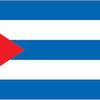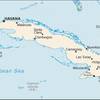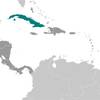Cuba [+]Compare [E]dit [H]istory
Aliases: Republic of Cuba, Republica de CubaObject «Cuba» was created due to
Add new object to «Cuba» or move existing objects here.
Object «Cuba» has attributes [Show empty attributes][Hide empty attributes]
| Attribute | Value |
|---|---|
| Geography | |
| Area | 110,860 km² |
| Continent | North America |
| Land area | 109,820 km² |
| Water area | 1,040 km² |
| Land boundaries | 28.5 km |
| Border countries |
|
| Coastline | 3,735 km |
| Mean elevation | 108 m |
| Lowest point | 0 m |
| Highest point | 1,974 m |
| People | |
| Population | 11,059,062 |
| Official languages |
|
| Religion | Christian |
| Government | |
| Long country name | Republic of Cuba |
| Short country name | Cuba |
| Long local name | Republica de Cuba |
| Short local name | Cuba |
| Former name | Add |
| Government type | Communist state |
| Capital | Havana |
| Economy | |
| GDP (PPP) | 137,000,000,000 USD |
| GDP (OER) | 93,790,000,000 USD |
| GDP (real growth rate) | 1.6 % |
| GDP - per capita (PPP) | 12,300 USD |
| Gross national saving | 11.4 % of GDP |
| Labor force | 4,691,000 |
| Unemployment rate | 2.6 % |
| Population below poverty line | Add |
| Budget revenues | 54,520,000,000 USD |
| Budget expenditures | 64,640,000,000 USD |
| Military expenditures | 2.87 % of GDP |
| Taxes and other revenues | 58.1 % of GDP |
| Budget surplus or deficit | -10.8 % of GDP |
| Public debt | 47.7 % of GDP |
| Inflation rate | 5.5 % |
| Central bank discount rate | Add |
| Commercial bank prime lending rate | Add |
| Stock of narrow money | 23,260,000,000 USD |
| Stock of broad money | 23,260,000,000 USD |
| Stock of domestic credit | Add |
| Market value of publicly traded shares | Add |
| Current account balance | 985,400,000 USD |
| Exports | 2,630,000,000 USD |
| Imports | 11,060,000,000 USD |
| Reserves of foreign exchange and gold | 11,350,000,000 USD |
| External debt | 30,060,000,000 USD |
| National currency | Cuban pesos |
| National currency (code) | CUP |
| National currency (symbol) | |
| National currency rate to USD | 1 |
The native Amerindian population of Cuba began to decline after the European discovery of the island by Christopher COLUMBUS in 1492 and following its development as a Spanish colony during the next several centuries. Large numbers of African slaves were imported to work the coffee and sugar plantations, and Havana became the launching point for the annual treasure fleets bound for Spain from Mexico and Peru. Spanish rule eventually provoked an independence movement and occasional rebellions were harshly suppressed. US intervention during the Spanish-American War in 1898 assisted the Cubans in overthrowing Spanish rule. The Treaty of Paris established Cuban independence from Spain in 1898 and, following three-and-a-half years of subsequent US military rule, Cuba became an independent republic in 1902 after which the island experienced a string of governments mostly dominated by the military and corrupt politicians. Fidel CASTRO led a rebel army to victory in 1959; his authoritarian rule held the subsequent regime together for nearly five decades. He stepped down as president in February 2008 in favor of his younger brother Raul CASTRO. Cuba's communist revolution, with Soviet support, was exported throughout Latin America and Africa during the 1960s, 1970s, and 1980s. Miguel DIAZ-CANEL Bermudez, hand-picked by Raul CASTRO to succeed him, was approved as president by the National Assembly and took office on 19 April 2018. The country faced a severe economic downturn in 1990 following the withdrawal of former Soviet subsidies worth $4-6 billion annually. Cuba traditionally and consistently portrays the US embargo, in place since 1961, as the source of its difficulties. As a result of efforts begun in December 2014 to re-establish diplomatic relations with the Cuban Government, which were severed in January 1961, the US and Cuba reopened embassies in their respective countries in July 2015. The embargo remains in place, and the relationship between the US and Cuba remains tense. Illicit migration of Cuban nationals to the US via maritime and overland routes has been a longstanding challenge. On 12 January 2017, the US and Cuba signed a Joint Statement ending the so-called "wet-foot, dry-foot" policy – by which Cuban nationals who reached US soil were permitted to stay. Illicit Cuban migration by sea has since dropped significantly, but land border crossings continue. In FY 2018, the US Coast Guard interdicted 312 Cuban nationals at sea. Also in FY 2018, 7,249 Cuban migrants presented themselves at various land border ports of entry throughout the US.
Similar objects
Most often compared with
Everyone can something to edit or add.
There was one edit, no edits waiting approval. Last edited by romaguera.shemar(9697), Sep 16, 2019 (57 fields were changed)
Help · Contact us · Disclaimer · Contributors · Developers · Donate


